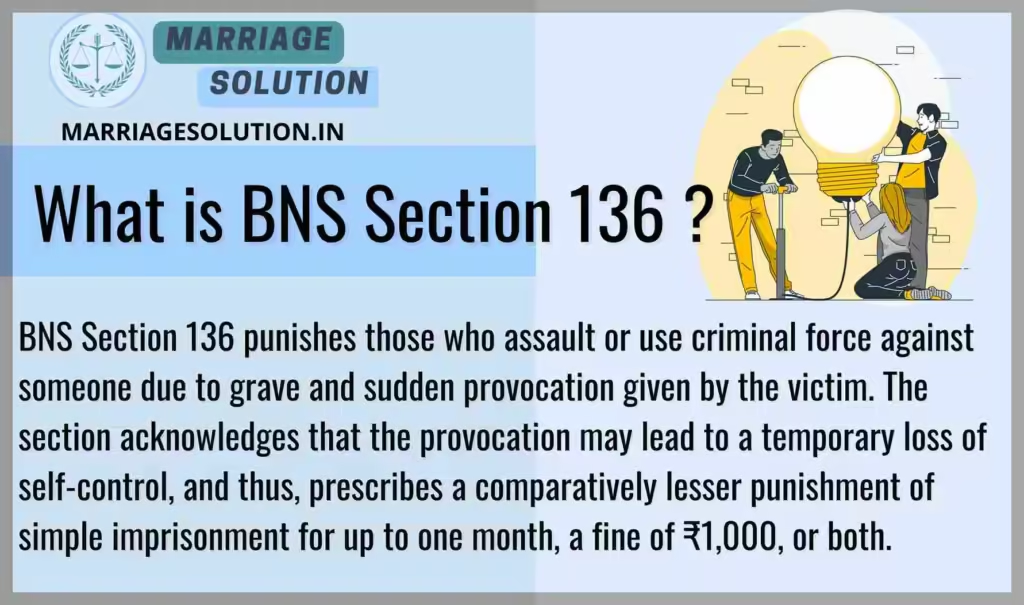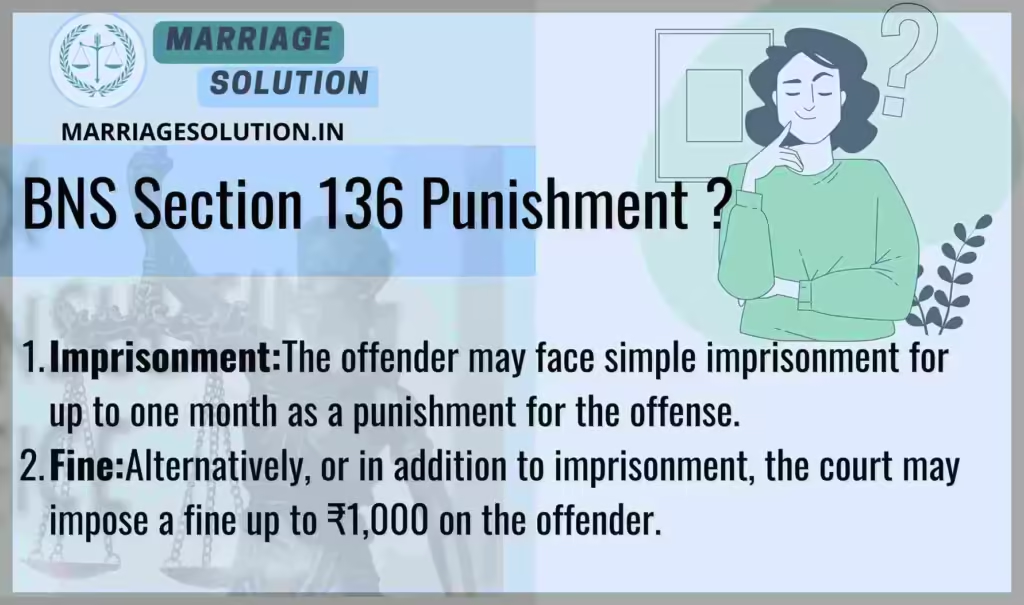Introduction of Section 136 BNS
BNS 136 recognizes situations where a person, due to grave and sudden provocation, reacts by committing assault or using criminal force. Unlike planned or intentional assaults, this section considers that provocation may cause a temporary loss of self-control. Therefore, the law prescribes a lighter punishment of simple imprisonment up to one month, or a fine up to ₹1,000, or both. This ensures that justice is fair and proportionate, distinguishing between premeditated attacks and provoked reactions.
The Bharatiya Nyaya Sanhita (BNS) Section 136 replaces the old Indian Penal Code (IPC) Section 358.
- Introduction of Section 136 BNS
- What is section 136 of BNS ?
- Under Section 136 of the bns act 2023
- Section 136 BNS Overview
- BNS 136 Punishment
- BNS 136 bailable or not ?
- Bharatiya Nyaya Sanhita Section 136
- Comparison Table – BNS Section 131 vs BNS Section 136
- BNS Section 136 FAQs
- Need Legal Support?
- Conclusion
What is section 136 of BNS ?
BNS Section 136 punishes those who assault or use criminal force against someone due to grave and sudden provocation given by the victim. The section acknowledges that the provocation may lead to a temporary loss of self-control, and thus, prescribes a comparatively lesser punishment of simple imprisonment for up to one month, a fine of ₹1,000, or both.

Section 136 BNS explained
“Whoever assaults or uses criminal force on another person on grave and sudden provocation given by that person, shall be punished with simple imprisonment for a term which may extend to one month, or with fine which may extend to one thousand rupees, or with both.”
This section deals with assault or criminal force used as a result of grave and sudden provocation caused by the victim.
- If someone insults, abuses, or provokes another person suddenly and seriously, and the person reacts with a slap, push, or use of force, the law treats it as less serious than a normal assault.
- The maximum punishment is simple imprisonment up to 1 month, or a fine up to ₹1,000, or both.
- The offense is non-cognizable (police need a warrant to arrest), bailable (accused can easily get bail), and compoundable (parties can settle the matter out of court).
Key Elements of Section 136
- Grave & Sudden Provocation → The victim must have provoked the offender suddenly and seriously.
- Assault or Criminal Force → The offender reacts by slapping, hitting, or using other force.
- Reduced Punishment → Law gives lighter punishment (1 month max jail / ₹1,000 fine).
- Intent Matters → The reaction must be due to immediate provocation, not planned or deliberate.
- No Hard Imprisonment → Only simple imprisonment is prescribed, not rigorous.
- Non-Cognizable → Police cannot arrest without a warrant.
- Bailable → The accused can get bail.
- Compoundable → Can be settled between the accused and the victim.
- Trial by Any Magistrate → The case is simple and handled in lower courts.
- Linked with Section 131 → Both sections deal with assault, but Section 136 provides leniency if provocation exists.
Examples to Understand Section 136
Example 1 (Provoked Slap):
During a heated argument, Ravi is insulted publicly by Ajay. Feeling humiliated, Ravi slaps Ajay.
Since Ravi acted under grave and sudden provocation, punishment will be lighter under Section 136 (max 1 month jail or ₹1,000 fine).
Example 2 (Provoked Push):
Seema’s neighbor falsely accuses her of theft in front of others. In anger, Seema pushes the neighbor.
This push, caused by sudden provocation, is punishable under Section 136 with reduced penalty.
Why Section 136 is Important
- Recognizes human emotions and how sudden provocation can trigger reactions.
- Provides leniency in punishment where the victim partly caused the situation.
- Differentiates between planned assaults and provoked reactions.
- Helps ensure justice is fair and proportional, not excessively harsh.
Section 136 BNS Overview
BNS Section 136 deals with cases where a person assaults or uses criminal force on another person due to grave and sudden provocation caused by the victim. The section recognizes that such provocation can momentarily push the accused to lose control, and thus, it provides a reduced punishment of simple imprisonment up to one month, a fine of up to ₹1,000, or both.
BNS Section 136 Overview :10 Key Points
- Covers Provoked Assault:
This section deals with situations where someone assaults another person after being gravely and suddenly provoked by the victim. - Grave and Sudden Provocation:
The provocation must be serious and happen suddenly to justify a reduced punishment under this section. - Lesser Punishment:
Since the crime is done under provocation, the punishment is lighter, with simple imprisonment for up to one month, or a fine up to ₹1,000, or both. - Simple Imprisonment:
If imprisonment is imposed, it will be simple, meaning no hard labor is required. - Fine Provision:
If the court deems it appropriate, the offender may instead be fined up to ₹1,000, or a combination of both fine and imprisonment. - Non-Cognizable Nature:
As a non-cognizable offense, the police cannot arrest the accused without obtaining a warrant from the court. - Bailable Offense:
The offense is bailable, meaning the accused can be released on bail pending trial. - Compoundable Offense:
The offense is compoundable, which means that the victim can agree to settle the case out of court, usually with the consent of the judge. - Triable by Any Magistrate:
This offense can be tried by any magistrate, making it easier to handle the case at lower courts. - Explanation Linked to Section 131:
The section refers to Section 131 for a similar explanation regarding provocation and its impact on legal outcomes.
BNS Section 136: Examples
- Example 1:
A person insults another during a heated argument. The insulted person, feeling deeply provoked, slaps the other in response. Since the slap was done under grave and sudden provocation, the punishment is less severe, in line with BNS Section 136. - Example 2:
A neighbor accuses a person of theft in front of others without evidence, causing the person to feel insulted. The person pushes the neighbor out of anger. In such a case, because the action was a response to sudden provocation, the punishment may be lighter under BNS Section 136.
BNS 136 Punishment
- Imprisonment:
The offender may face simple imprisonment for up to one month as a punishment for the offense. - Fine:
Alternatively, or in addition to imprisonment, the court may impose a fine up to ₹1,000 on the offender.

BNS 136 bailable or not ?
Yes, BNS Section 136 is a bailable offense, meaning the accused can apply for bail and may not necessarily remain in custody before the trial.
Comparison: BNS Section 136 vs IPC Section 358
| Section | What it Means | Punishment | Bail | Cognizable? | Trial By |
|---|---|---|---|---|---|
| BNS Section 136 | Covers assault or use of criminal force on grave and sudden provocation given by the person assaulted. Recognizes human reaction under provocation. | Imprisonment up to 1 year, or fine up to ₹1,000, or both. | Bailable (accused can seek bail) | Non-Cognizable (police need warrant to arrest) | Any Magistrate |
| IPC Section 358 (Old) | Earlier law dealing with assault or use of criminal force on grave and sudden provocation. Essence same, language more archaic under IPC. | Imprisonment up to 1 year, or fine up to ₹1,000, or both (same as BNS). | Bailable | Non-Cognizable | Any Magistrate |
BNS Section 136 FAQs
What is BNS Section 136 about?
It deals with assault or criminal force used on a person due to grave and sudden provocation by that person.
What punishment is prescribed under BNS Section 136?
The offender may face simple imprisonment for up to 1 month, or a fine up to ₹1,000, or both.
Is BNS Section 136 a bailable offense?
Yes, this is a bailable offense.
Can the offense under BNS Section 136 be compounded?
Yes, it is a compoundable offense, meaning the matter can be settled between the parties.
Is the offense under BNS Section 136 cognizable?
No, it is a non-cognizable offense, meaning the police cannot arrest without a warrant.
Who can try the offense under BNS Section 136?
The offense is triable by any magistrate.
Need Legal Support?
If you’re facing court proceedings, marriage-related issues, or any legal matter, our team at Marriage Solution – Lawyer Help is ready to guide you. Just complete our easy online enquiry form, and we’ll connect you with the right legal assistance tailored to your needs.
Conclusion
Section 136 of the Bharatiya Nyaya Sanhita strikes a balance between justice and human psychology. It acknowledges that when a person is suddenly and gravely provoked, their reaction may not carry the same level of blame as an unprovoked assault. By prescribing lighter punishment, it differentiates between deliberate violence and provoked actions. When compared with Section 131, the law ensures fairness by imposing stricter penalties in cases of unprovoked force while providing leniency in situations where provocation played a significant role.
Finished with BNS 136 ? Continue exploring the next provisions of the Bharatiya Nyaya Sanhita (BNS), 2023. Each section includes explanations, examples, and plain-language breakdowns for easy understanding.
- 137 BNS : Kidnapping.
- https://marriagesolution.in/bns_section/137-bns/
- 138 BNS : Abduction.
- https://marriagesolution.in/bns_section/138-bns/
- 139 BNS : Kidnapping or maiming a child for purposes of begging.
- https://marriagesolution.in/bns_section/139-bns/
- 140 BNS : Kidnapping or abducting in order to murder or for ransom etc.
- https://marriagesolution.in/bns_section/140-bns/
- 141 BNS : Importation of girl or boy from foreign country.
- https://marriagesolution.in/bns_section/141-bns/
Full IPC Section List: https://marriagesolution.in/ipc-section-list
All Indian Law & Blogs: https://marriagesolution.in/indian-law/
Full BNSS Section List: https://marriagesolution.in/bnss_section-list
